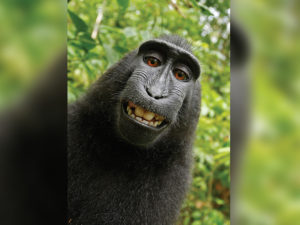
On September 11, photographer David Slater and the People for the Ethical Treatment of Animals (PETA) agreed to an out-of-court settlement on a two-year case regarding a set of so-called “monkey selfies” taken in Indonesia by a male crested black macaque named Naruto. PETA sued Slater for his use of the photos, claiming that since Naruto took the pictures, using equipment set up by Slater, the monkey was entitled to the copyrights for those images.
U.S. District Judge William Orrick, who ruled in favor of Slater one year earlier, stated in his ruling that the Copyright Act did not specifically indicate that its protections extended to non-humans. Indeed, it would be ridiculous if it did. While the idea of extending certain legal protections to animals, such as the macaques involved in the Slater case, is not unreasonable, especially when it comes to protecting animal habitats and preventing destruction of their populations, it is another thing entirely to promote the foolish idea that animals need (and can even appreciate) intellectual property rights.
The key question to ask here is who is able to create intellectual property. While research shows that many species of non-human primate have comparable intelligence to that of a human toddler, the fact that their intelligence is, at its greatest, no more so than that of the youngest of humans, is ample reason to discount the idea of providing them with copyrights. A 2-year-old human is incapable of creating anything worthy of legal protection under copyright or other law; consider that the youngest of patent holders have been at least five or six years of age, and therefore had matured to be past this point of intelligence comparable with monkeys. Furthermore, these are extreme cases that illustrate how unusual it is for someone who is not many years the wiser and more experienced to create something great.
One must also consider that the purpose of copyright, insofar as it is meant to protect the people who make art, is inherently designed to protect humans. Art may be a very abstract idea, but no matter the medium, to classify as such requires, at the least, deliberate intent to create something, must convey meaning and must require the use of technical skill by the artist. If you gave a kindergartener paint and a canvas and they splattered the paint in random patterns across the canvas, no one would consider it real art (except perhaps the child’s parents). Compare this to a Jackson Pollock painting, in which, although it may seem to be a similar chaotic mess of paint, is done deliberately, and the end result, though it may not be readily apparent, has meaning.
Bringing things back to the monkey selfies, it is obvious that any monkey, even if it is aware that the closing of a camera’s shutters does something, cannot be aware of the aesthetic value of the resulting photograph. More than likely, Naruto was just having fun with the camera, much the same as any toddler would if given a camera.
Copyright law is intended to prevent one’s artistic creation from being used for profit by anyone but the creator, so naturally this case brings up the additional problem that non-humans have no understanding of human finances. Even if the copyright were granted to Naruto, the resulting profits would be meaningless to him, unless he wanted to throw dollar bills around like someone in a music video. Hence, there is no point in involving lower primates in the capitalist system, as they would not understand the point of it anymore than the fact they would “own” intellectual property.
The settlement in the monkey selfie case is not a total waste of time, of course; Slater agreed to donate 25 percent of the profits from the use of the photos to charities that protect the macaque population he set out to photograph. Indeed, the publicity received by the case can only help raise awareness of this species that has become critically endangered due to destruction of habitats by humans. Thus, this legal battle to expand copyright protection, a concept that would be of zero value to a macaque, has still given these same macaques something that will help them — public knowledge of the dangers humans pose to these creatures and to their environment.
In the end, this case wrapped up the way it should: The idea of a copyright was not flipped on its head and perverted in a way it never should be, photographers were not punished for trying to create art that was intended to benefit endangered species and the macaques in question became a viral sensation that has served to highlight the damage they have suffered by human actions.








